And here we are already: the final day of SPIEL Essen 2024. It’s the first time in a while that I’ve attended SPIEL on a Sunday. I would usually just do my shopping/gaming Thursday and Friday and avoid the weekend in favour of playing my new acquisitions. But this year there were more people to meet and trying to record interviews as well as the daily coverage also more than filled my days. So it feels like a hot 5 minutes since I left my hotel to take the train to the Wednesday press conference.
First stop of the day was Galileo Galilei to complete the hattrick: I was fortunate to be able to play all three releases of newly published designer Tomás Holek (SETI, Tea Garden, and Galileo Galilei). Had a brief chat with Tomas and he told me how crazy Thursday was with the line going all the way back to the end of the hall and the speed of which they were selling copies being mostly limited by the electronic payment system. I heard from other publishers as well that it sometimes can pay off to have cash on hand when lines are long, as many would be able to process these buyers in parallel.
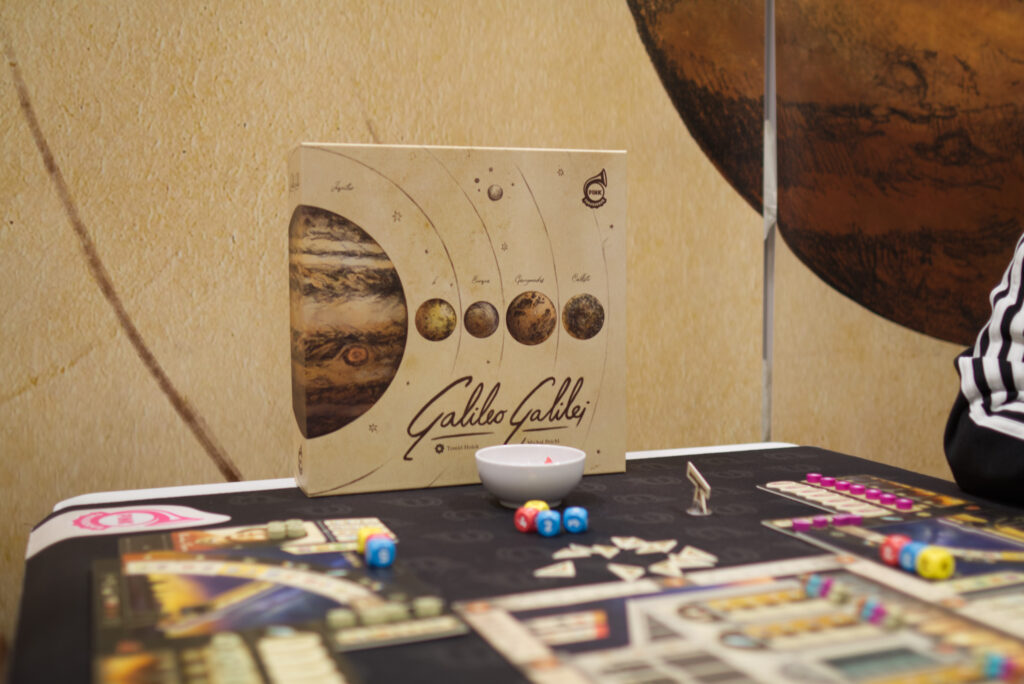
Playing Galileo Galilei, one thing that immediately becomes apparent is how lovely the art of the game is. Even before the game started I was in a good mood for what’s to come as I saw a moveable telescope on my player board and beautifully illustrated cards on the main board. Players are astronomers trying to make discoveries without getting in bad standing with the inquisition. The whole topic of Galileo and the inquisition is of course a tragic one, but the game manages to interestingly turn the inquisition into something that the players can use to their advantage if they are careful. My head-canon immediately turned the respective action into “inquisition marketing”, but I digress.
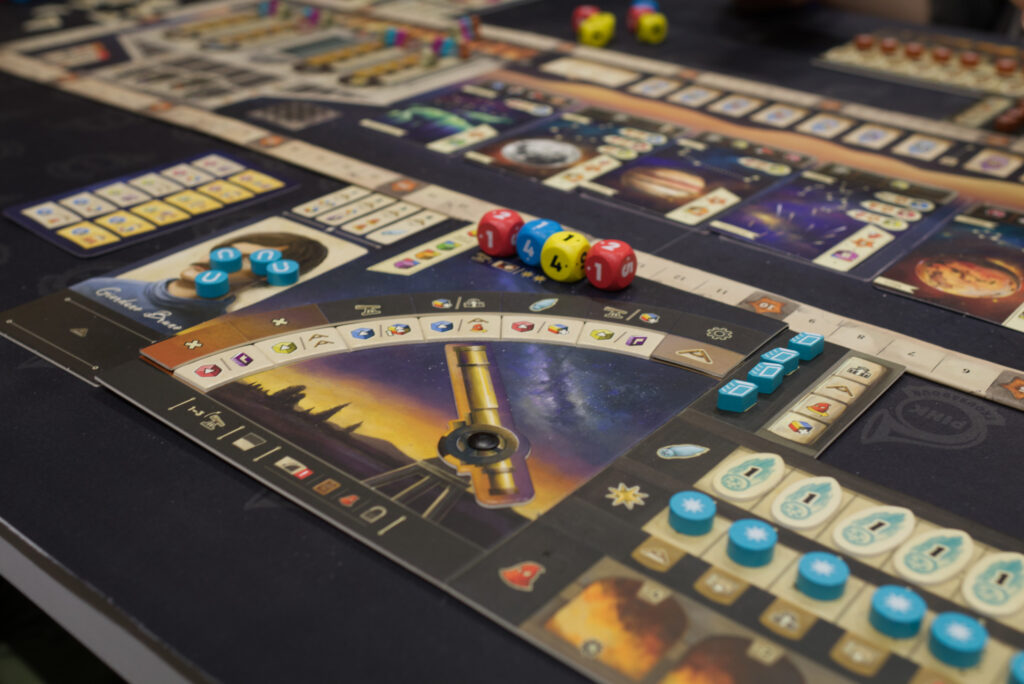
Galileo Galilei is yet another game this year that uses dice not to roll them but as markers that can be manipulated. The core mechanic is that a player on their turn can move their telescope 1-3 steps upward (continuing at the third action from the bottom when going over the top) and performing both a fixed action printed on the board as well as a second action printed on a cardboard piece. That piece is then moved to the bottom of the telescope and all others pushed up, similar to Ark Nova. The similarity even goes so far that all the tiles can be flipped to an improved side via various bonuses. There are of course actions to make discoveries (claim cards and / or victory points on the central board), gain new dice or increment them, rise up on one of the university tracks (which provide end game VP multipliers) and things to get in better standing with the inquisition.
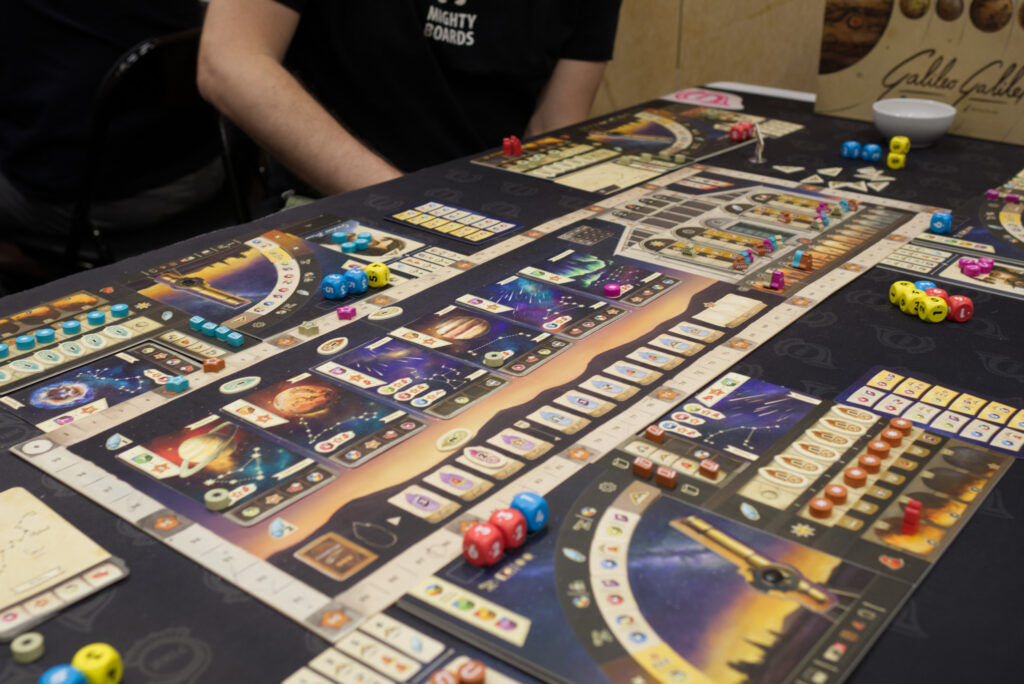
As with Tea Garden, what fascinated me about Galileo Galilei is that the mechanisms themselves are pretty standard, known Euro-game elements. Still, somehow Tomas again managed to make the mechanisms fade into the background and get me immediately hooked on the theme. I didn’t care that I had seen many of the mechanics before, I wanted to make certain discoveries and avoided getting on the inquisitions radar at all.
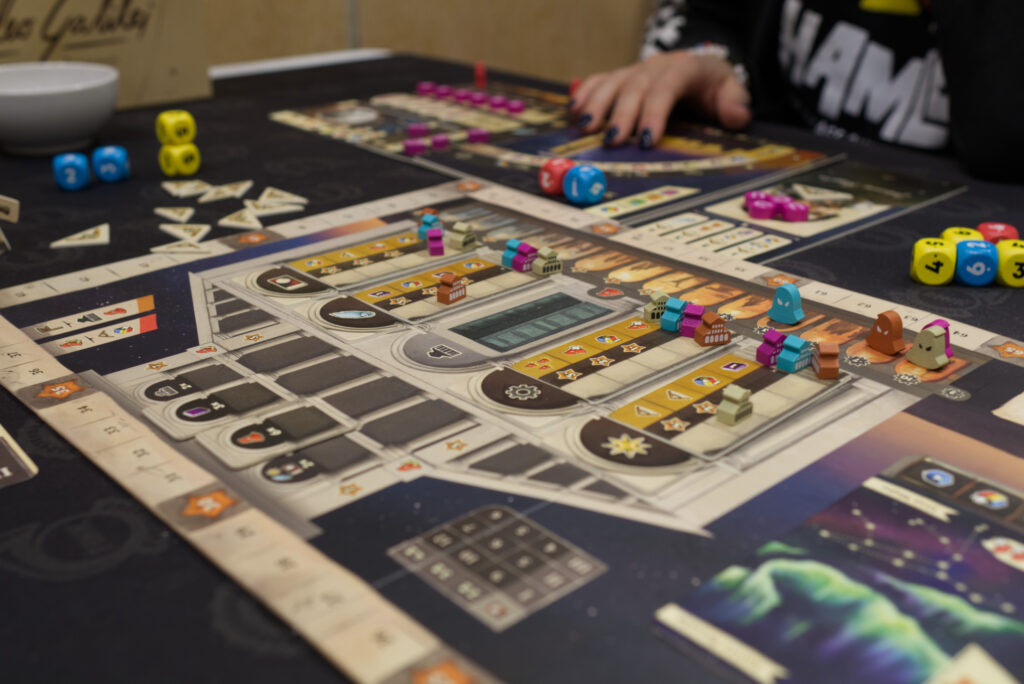
The game flowed very nicely since each individual turn was rather quick (move telescope, do both actions, 2-3 potential upkeep things, done) with the main challenge being getting the right values and colour combinations of dice to be able to claim those important discoveries. Major decisions are for example how big of a discovery the player wants to make: more remarkable ones produce more VP but attract attention from the inquisition, lesser ones not. Then there is the question which specific discoveries to make as the claimed cards form a library of 4 tracks on which the player can progress markers to gain bonuses. It’s a bit multi-player solitaire with the main interaction being competition for the discoveries on display. Overall very enjoyable game even if my co-players destroyed me due to too much lack of sleep writing late night blog posts 😀 If they would have had copies, probably all of us would have bought one.
Once we finished our demo (we played approx half a game before our time slot was up), I was up for special treat: an interview with Tomas! I had introduced myself to him the day before when he was at the CGE booth and he was so kind to spontaneously agree to sit down the next day. We chatted for about half an hour on all of his three games, the design ideas behind various mechanisms, his passion for the particular themes, and more. I’m super happy with the interview and it was great to get to know Tomas a bit. As with the other interviews I did at Essen, I will post it in the upcoming days once I have the transcription and editing ready. So stay tuned!
As I strolled through the halls flying on a high of another interview gone well, I realised how noticeably less people were roaming the halls this day. Still a lot of people, but definitely a bit less crowded. I dropped by the ION Games booth to watch a bit of a Kartini playthrough and was sad I had to cancel my slot, but meeting Tomas was definitely worth it. On the table, the game looked even more interesting than the day before when I only saw the box and components. Still no clue about how good the gameplay is, but ION Games has done an awesome job with the production!
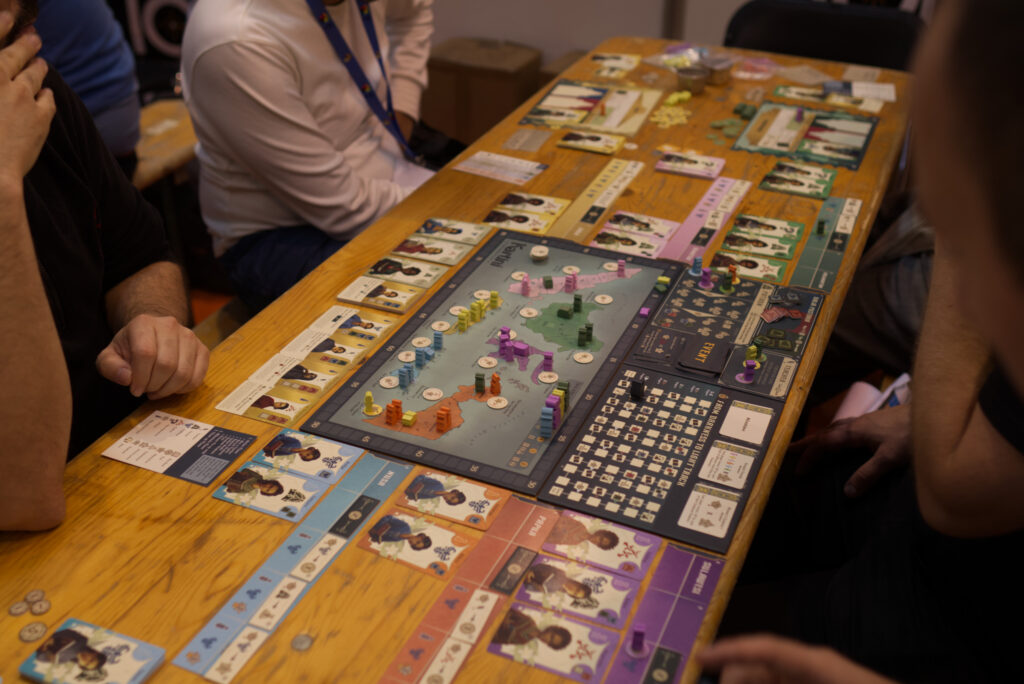
Also caught a quick glimpse of Pegasus’ Hands in the Sea pre-production copies but there was no empty table and so I moved on.
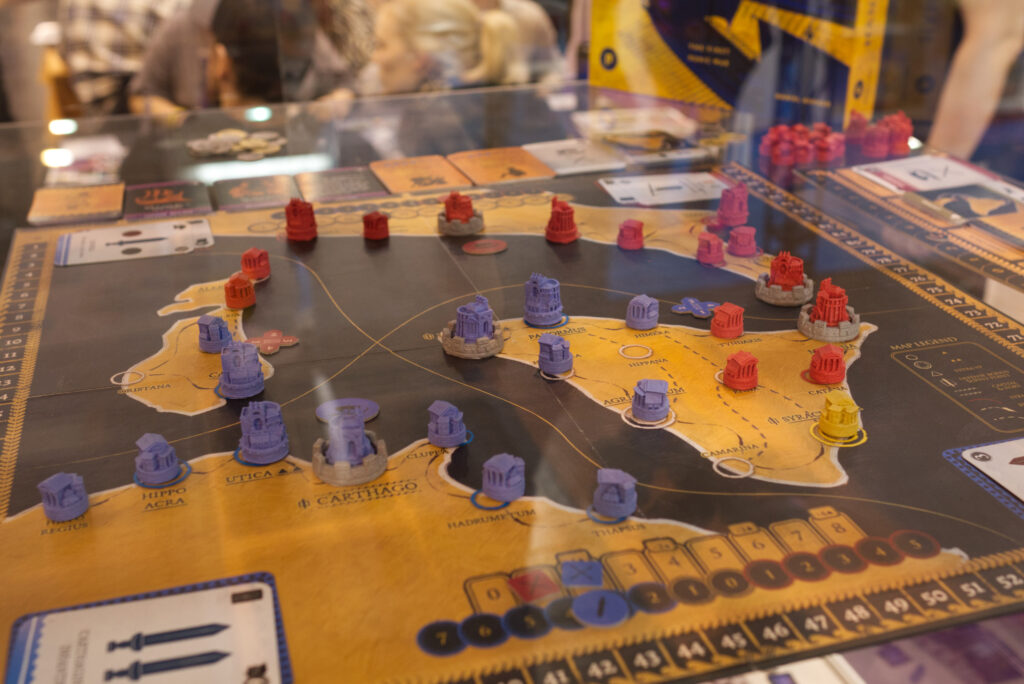
A lot of booths had parts of their price lists crossed out or individual titles covered with “sold out” signs while some publishers even closed their whole shop!
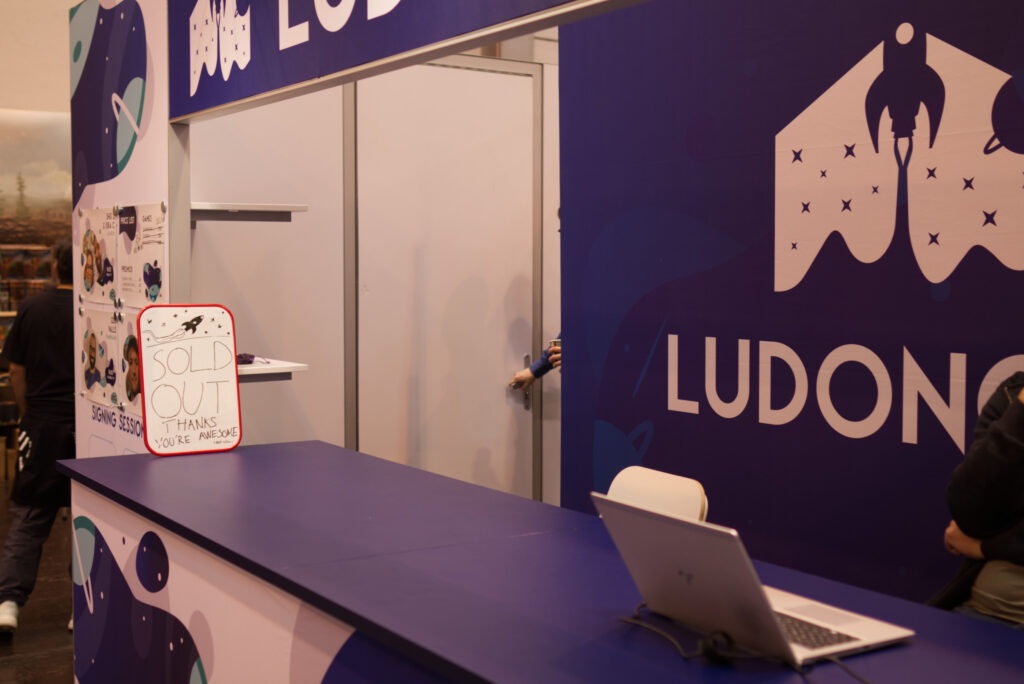
There were still some good deals to be made though as a few (but not many) shops had lowered their prices for Sunday. Knowing the amount of games I had already shipped home on Saturday or still had to carry home, I only picked up one thing that was just too good to resist: Lucky Duck Games had the new Tranquility the Ascent (retail edition) for 10€ on sale. This little co-op/solo game is one of my favourite cozy puzzlers. I even went so far as to fashion my own PnP version back when the game was in Kickstarter limbo as the original publisher failed and before Lucky Duck came in to save the project.
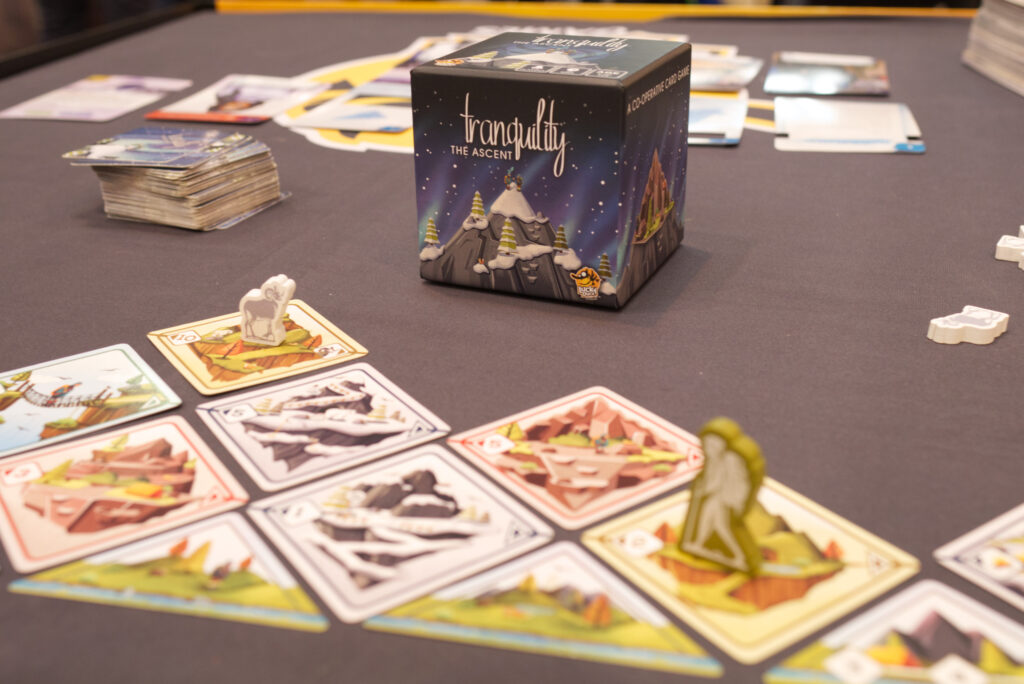
In Tranquility the Ascent, players draw and place square cards with numbers on them (and of three different colours) to climb a mountain. The goal is to get to the summit before any player’s deck runs out. No two cards of the same colour are allowed next to each other in the same row and when a new card is placed, one has to pay the difference in numbers in additional cards. E.g. placing a 4 next to a 4 has no penalty, placing a 4 next to a 6 costs an additional 2 cards. Also the number indicates up to which level it can be played (e.g. a 3 can only be placed on level 1-3). The base game is already fun, but easy to master with a little practice. There are however various modules that even can be combined to increase the difficult, from having to herd goats up the mountain to having to create certain combinations of numbers. So happy this game finally exists, especially for James the designer and the Tristam the artist after all they went through with this game. Picked up three copies as gifts despite already having 3 KS versions that should be fulfilled soon. By the end of the show, they had sold out of all copies.
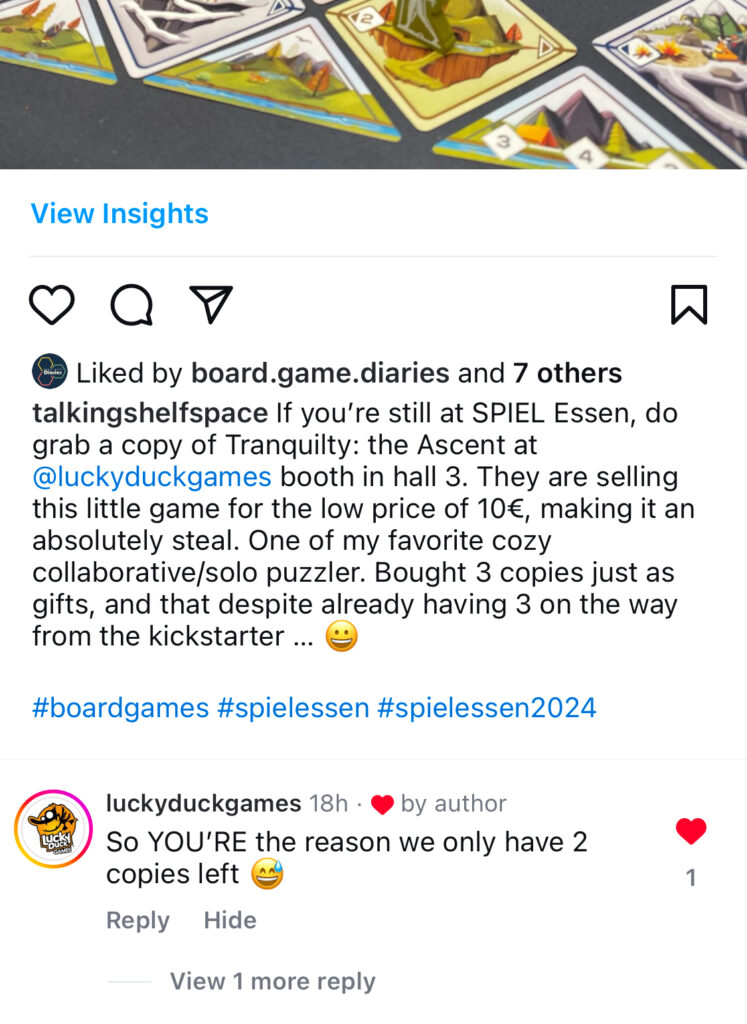
Next, I set down to play Stonemaier Games new release Stamp Swap which is a beautifully illustrated I-cut-you-choose game. Over three rounds, players first pick stamps from a new offering which is created by revealing a number of cards showing the various stamp sizes and if they should be face up or face down. After everyone has picked 6, they reserve one for themselves and split the rest into two piles. The starting player then picks one pile while the chosen player gets to keep the other for themselves and then go next picking their second pile. So it’s a typical dilemma of how to split so you can get the stamps you need and should you pick a stamp in the beginning in hopes you can keep that pile for yourself or let someone else pick because you’ll know you’ll select that pile. Once your new stamps are puzzled into your board, you have to choose one of five potential scoring cards (e.g. x points for all cards of one colour), each of which can only be used once per game.
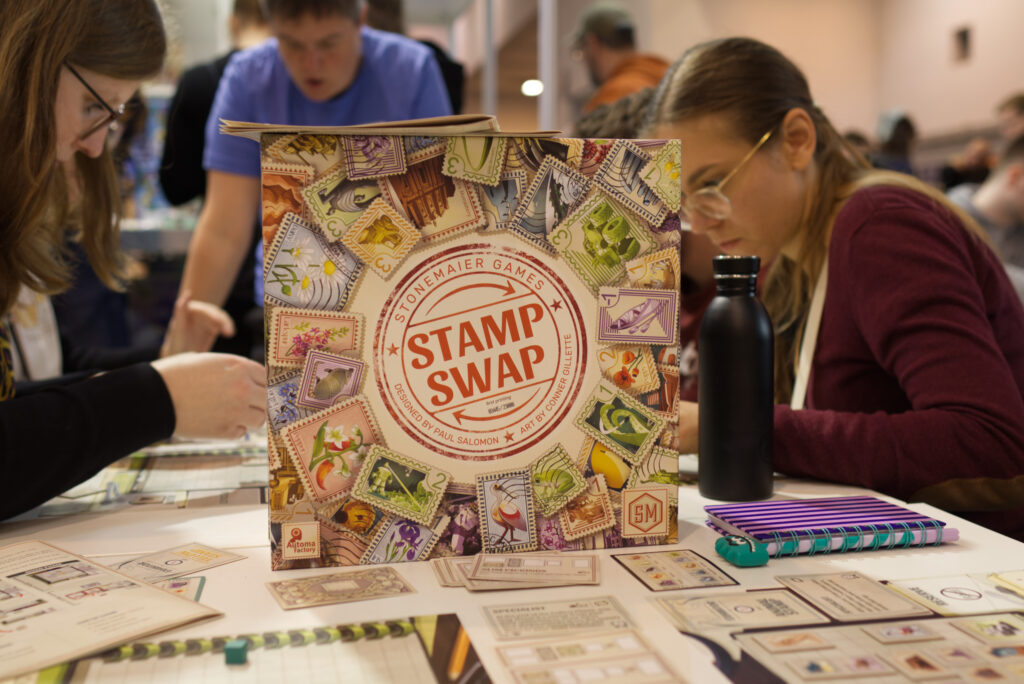
I’m not a fan of the I-cut-you-choose mechanism and for example didn’t like It’s a Wonderful Kingdom at all. Stamp Swap however was fun, which surprised me. Part of it is likely that it of course is a very light game and the consequences of one’s actions aren’t that dramatic, so it’s less of a disappointment if one draft doesn’t work out. In the end you always end up with a collection of beautiful stamps. There are a few elements like special powers or each player having a certain type of stamp that gives them extra points, but having only three rounds made me wanting more somehow. Funny enough, the group I was playing with same as me was reminded of Fit to Print and how the puzzling there is way more consequential. As you can see in the image below, there was no problem at all fitting all my collection into the board. Still, it was an easy, delightful game to play. The art is gorgeous but unfortunately there are major usability issues as it’s hard to figure out what type a stamp is (colour does not equate type as type is indicated by the pattern in the background!), the 2-stamps-on-one-tile tiles looked like two separate ones on the cards that distinguish a rounds new offering, and so on. I can see this speak to none-gamers due to its presentation, but for me and my group, I would never get this to the table except maybe solo. But even then the question is: why not play Fit to Print which is more puzzly? Would be curious to try the solo mode though and likely the more complicated goals cards would increase the challenge.
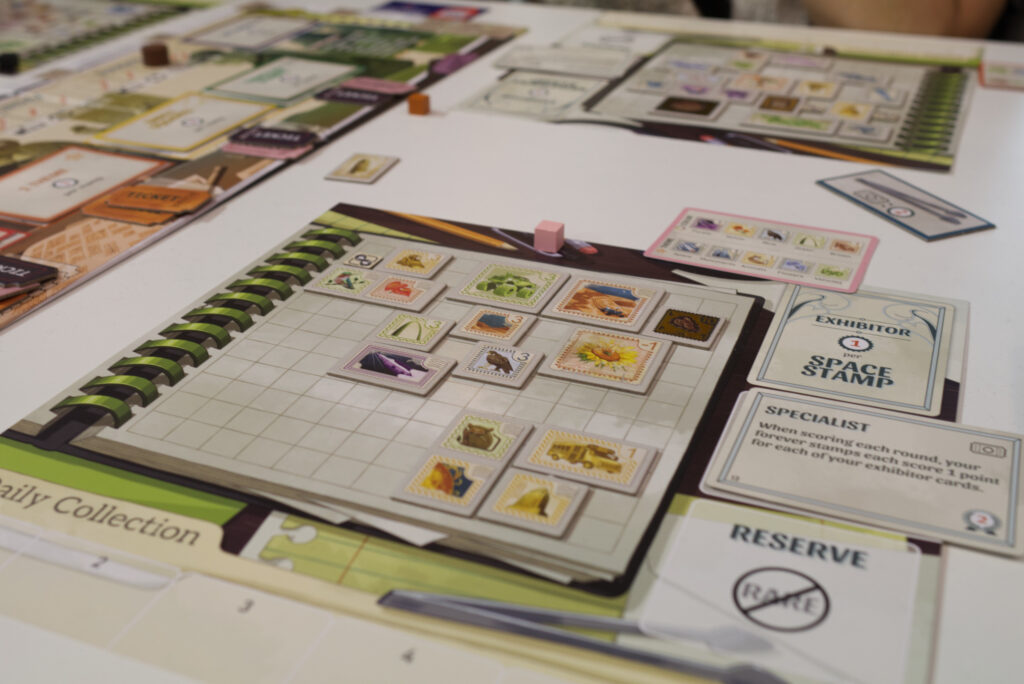
By now, I had gotten into the habit of taking a short break after each game or interview I did. Rushing from game to game, it’s easy to forget to drink enough and the constant noice in the halls is also quiet taxing on everyone’s voice. At one point I noticed I couldn’t really tell if I had eaten anything since my early breakfast, so much had already happened that day!
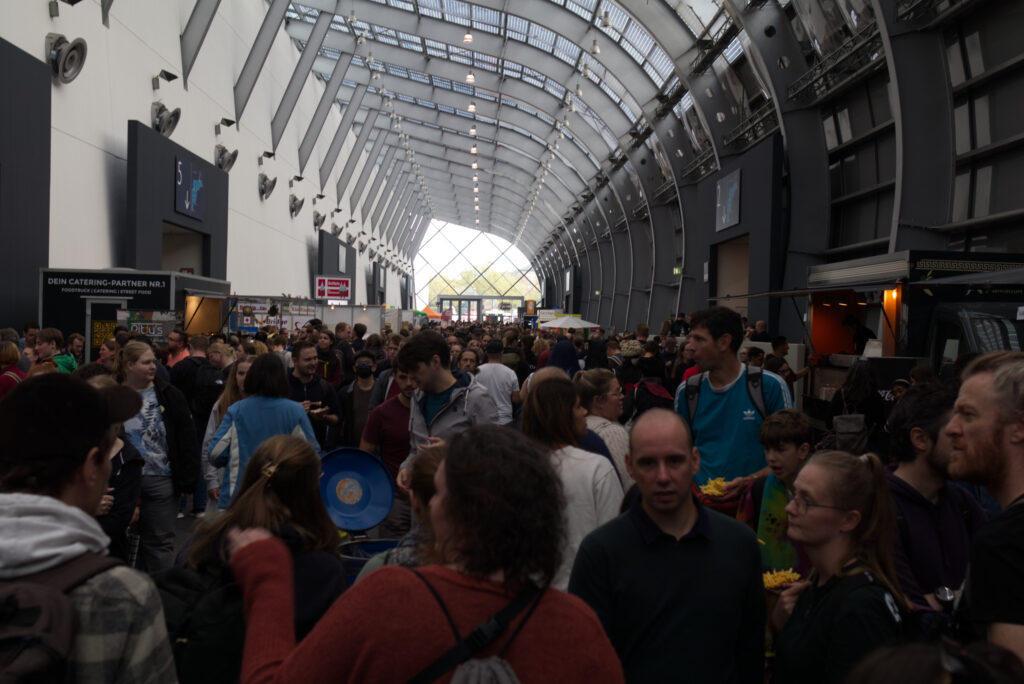
After spotting it at the novelty show on Wednesday, I definitely couldn’t leave SPIEL without having tried Quiet House by Mandoo Games. It’s a 2-4 player no communication deduction game. Each player sees four cards, two per edge, that indicate which of the objects should be the left most and second left most in that direction. Each piece has different movement rules and each round a card is revealed both as a game timer and to indicate which piece cannot be moved that round. When it’s a player’s turn, they can either move one piece – or – if they are completely happy, raise their panel and indicate they love what they are seeing. The other players then also raise their panel and let everyone know if they are happy or not. If all are, the game is won, if the deck runs out before that, the game is lost.
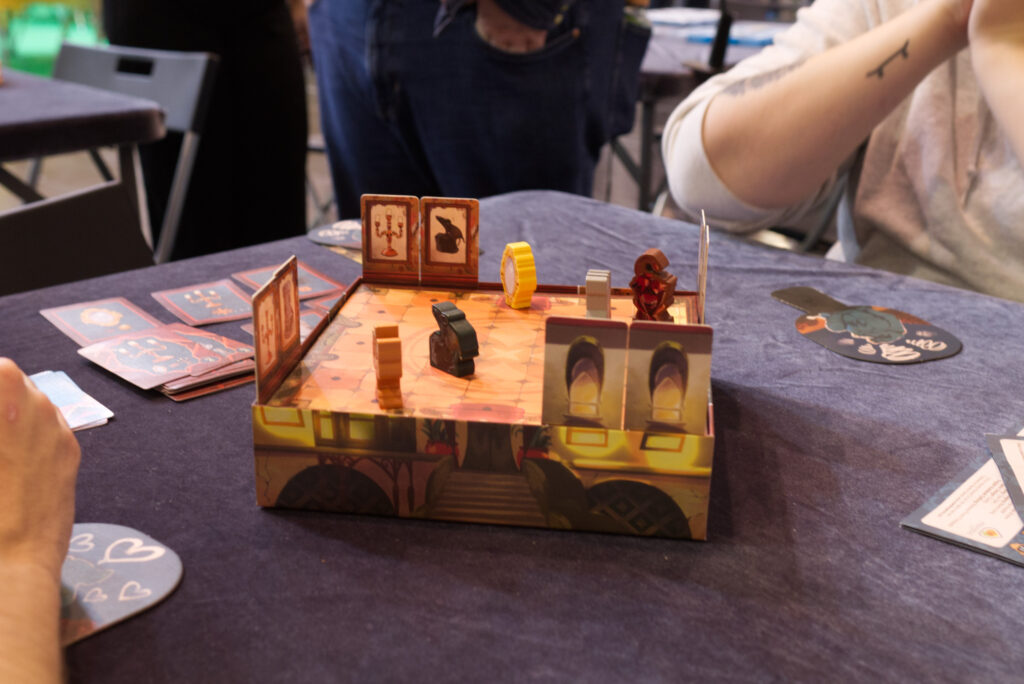
Quite House was unfortunately an example of why a bad rules teach can ruin a game: the person at the booth had taught it as “you can move AND raise your panel” which makes things way too easy. The real challenge is created by one core rule: no two pieces can be on the same row or column, ever! As a result, sooner or later players will get into a situation where someone has to destroy partial correct constellations in an effort to make space and move another piece towards the right direction. We managed to win with the last card, which felt very satisfying, and knowing that harder movement rules are on the back of the movement cards got me to a point where I would have bought a copy … just to find out it’s another game that was sold out. Not sure when it did, but it was already afternoon of the last day so it’s no wonder. Charming little deduction game. Would have loved to replay and try the harder version.
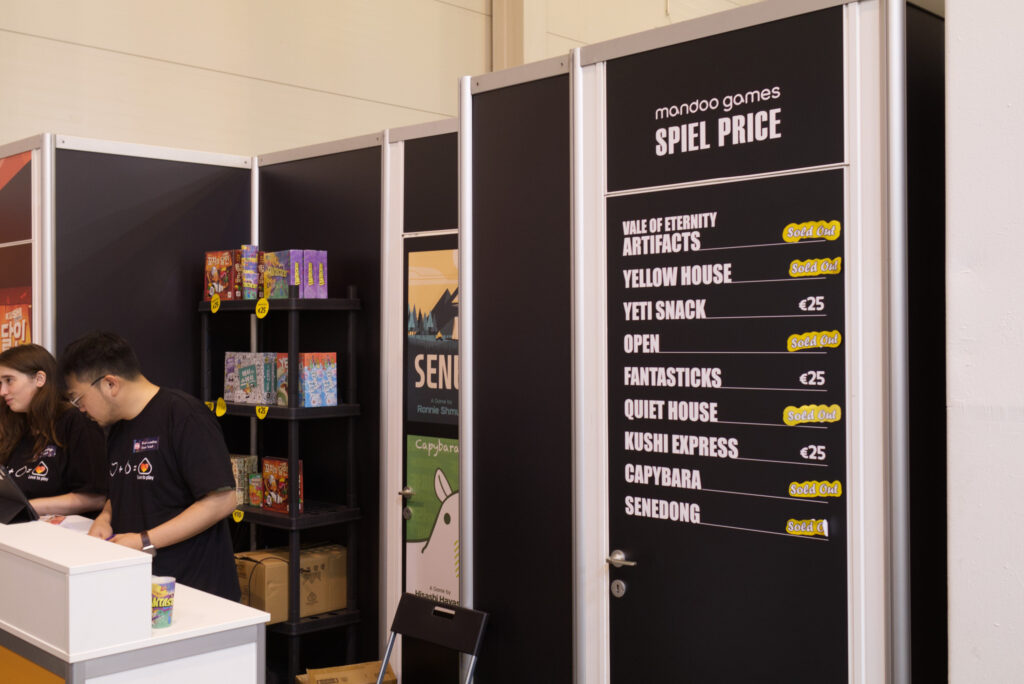
One benefit of Sunday is that after lunch, a lot of people already will have left to catch planes or start their otherwise long rides home. As I walked through hall 3, I thus saw an empty table at Firefighters on Duty. This gave me a strong Curse of the Template vibe as players frantically role dice to move their fire trucks through town, move fire fighters, and put out fires. There seems to be a lot in the box: from fire trucks only having limited amounts of water, special mechanisms to break down debris, injured people that need to be saved, and so on. We only played one round – which only lasts 2 timed minutes – but it ended in disaster: both my fireman didn’t make it out of the burning building and the fire in the centre of the city began to spread. There definitely are more mechanics at play here than in Curse of the Template, which kind of got me intrigued. Alas, it was demo only and so I didn’t have to think about whether I should pick up a copy or not. I was a bit tempted despite knowing I would never get this to the table with my usual play group.
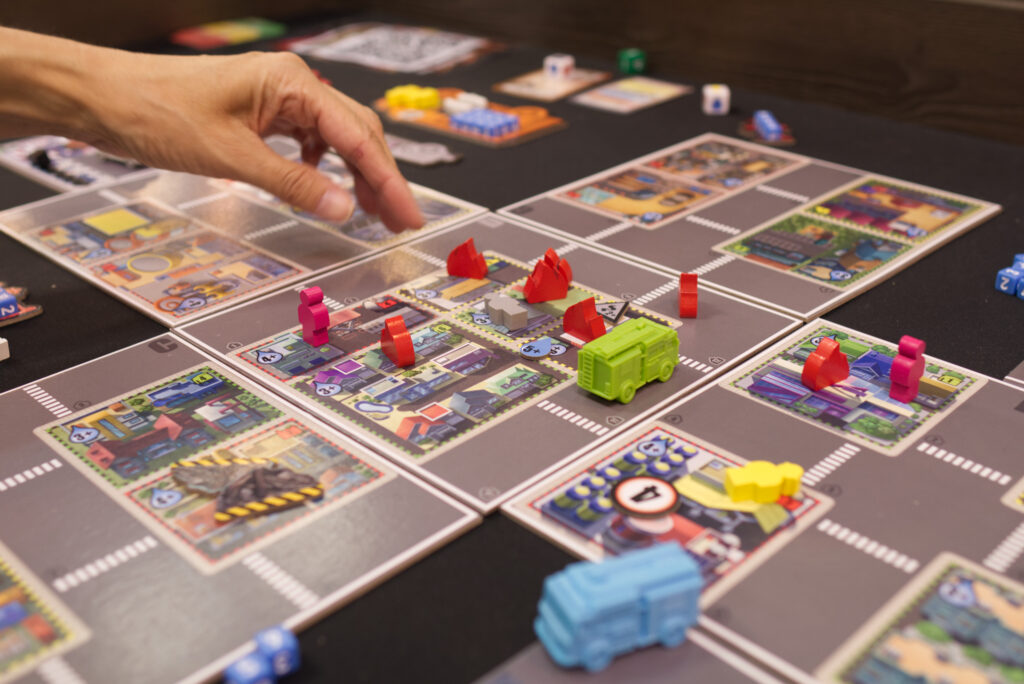
As I did my final round to say goodbyes – and let’s be honest keep my eye open for last minute deals – I was happy to see that Daitoshi had also sold out by Sunday afternoon. There had been copies left in the morning, so I would say Devir managed to bring just the right amount of copies. Still haven’t had a chance to play my copy but I’m very much looking forward to it.
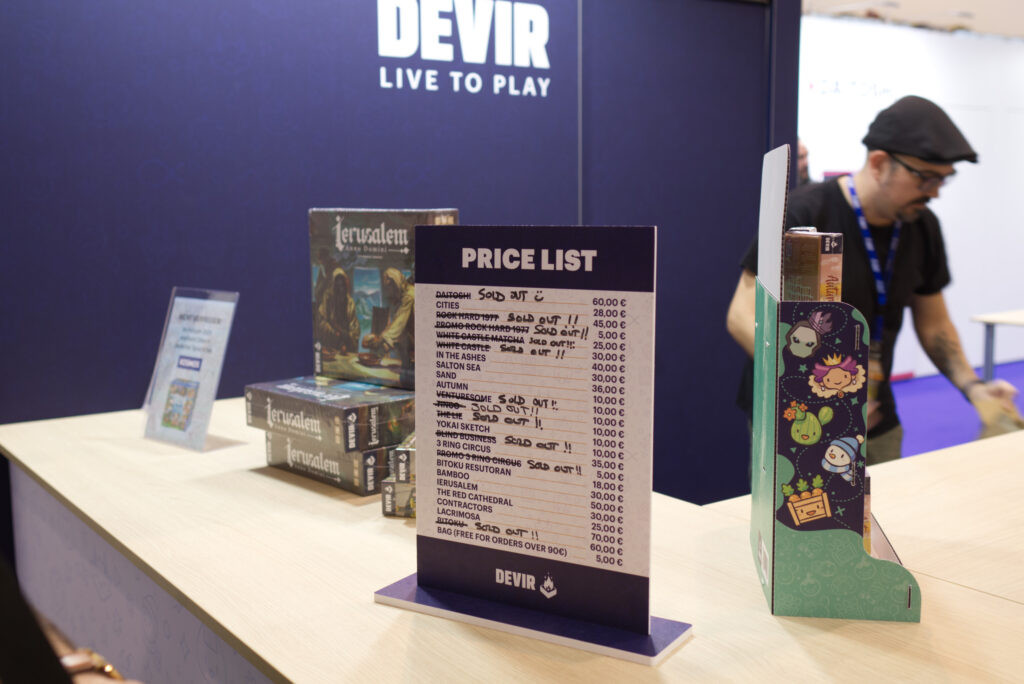
With the fair near its end, I had the unexpected pleasure of talking with Carol Rapp, head of SPIEL Essen, for a short interview. Super grateful she took the time and it turned out to be more fun than I had even hoped. As with the other interviews, I’ll need time to transcribe and edit them, so stay tuned! One thing that stuck with me though is how even briefly having had a chance to look at the behind the scenes things going on in the SPIEL team’s office renewed my appreciation for what they are doing. We see SPIEL with its 200,000 attendees, large halls, and publishers but it’s important to keep in mind all of that is organised by way less people than you might think. And there are many aspects they have to consider that you and I have no clue are even a thing!
On my way out, I gave Goghme a play which is a connect-four with a twist: the spaces are metal discs and the play pieces are magnetic. On your turn, you can either place a piece or pick up a piece on the board, flip the disc, and thus put it “underneath”. It was quite interesting to have this memorisation tasks in combination with the usual connect four, but in the end it’s connect four … how often would I play this really? And while the pieces were pretty, the production in total wasn’t on a level that I would just buy it as an art piece.
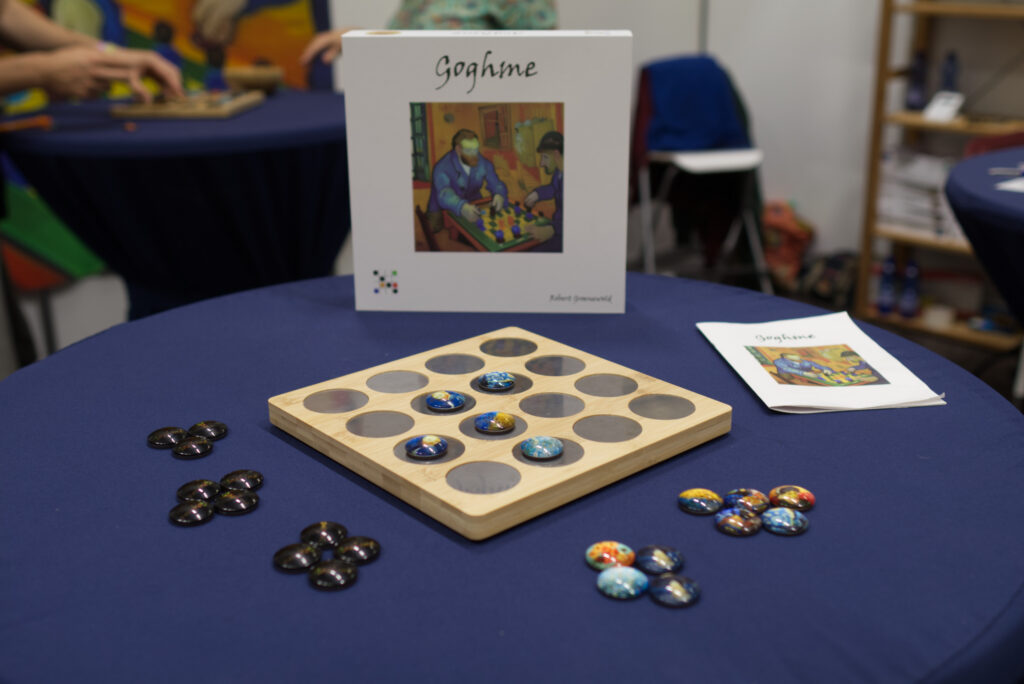
And with that, five days of SPIEL were already over. To be honest, it’s quite surreal how quickly time passed. Trying to both do a daily coverage AND interviews AND actually game something made for some short nights and busy days. It was a lot of fun and I especially enjoyed meeting so many people, from readers of my reviews to YouTubers that likely will have forgotten me by now to old and new acquittances.
I’ll be heading home now, but luckily there is still content to come:
- a wrap up of SPIEL Essen 2024 including highlights, what did I buy and what did I miss, what did it cost me to go to SPIEL, was it worth it
- the interview with Martin Wallace on Steam Power and other things happening at Wallace Design
- the interview with Tomáš Holek on Galileo Galilei, SETI, and Tea Garden
- the interview with Vangelis Bagiartakis on World Order
- the interview with Carol Rapp on SPIEL 2024
… and of course proper long form first impressions of the games I bought as is my usual format. Thanks again to all the nice people I met who took the time to chat, being it 5 minutes or 50 minutes:
Reni & Kristof of Board Game Diaries, Ryan & Malorie Laukat of Red Raven Games, Vangelis of Hegemony, Carol Rapp of SPIEL Essen, Tomas of Galileo Galilei/SETI/Tea Garden, Martin Wallace (I guess no need for an “of” here), Flo of Get on Board, Cardboard Rhino, Johannes & Sunniva of Board Game Ramblings, Tobi & Alexandra of Board Game Pirates, Jonathan Fryxelius of Kingdom Legacy, Mihir of Raas: A Dance of Love, Daniel of Heat: Pedal to the Metal, Derek of Heavy Cardboard, Robert of Arcane Wonders, Ben Maddox of 5G4D, Mac Gerdts of Concordia, Eric Martin & Candice Harris of BGG, Vincent Dutrait … I’m still sorry I mixed up board game titles Vincent! 😅

